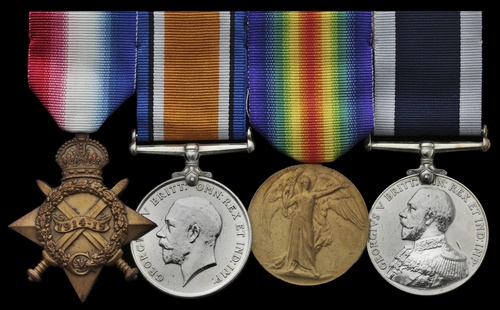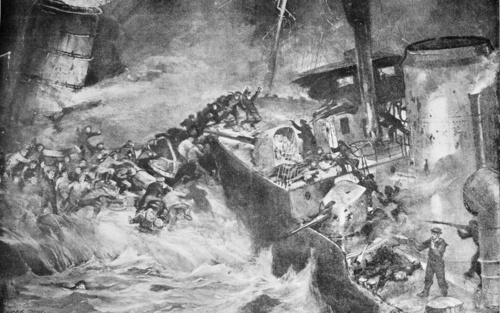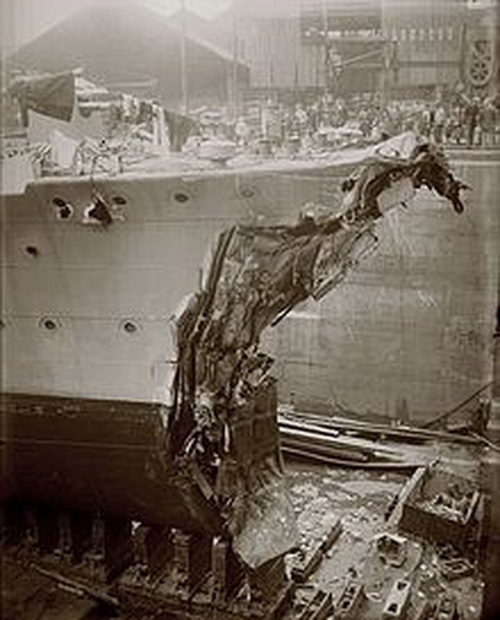Auction: 22003 - Orders, Decorations and Medals
Lot: 370
20-21 APRIL 1917: A FAMOUS FIREFIGHT IN THE DOVER STRAITS
'Many casualties had occurred among the guns' crews of the forecastle through two enemy shells, one of which had detonated projectiles in a ready rack. All the electric cables and voice-pipes from the bridge had been shot away, while the after compass, after wireless-room, and searchlight were demolished. The foremost funnel was pierced through and through by splinters until it resembled a huge nutmeg-grater. A shell passing in through the side above the waterline had penetrated a coal-bunker, to explode in the boiler-room beyond, killing or wounding every man in the compartment and severing the main steam-pipe, from which the steam escaped with a deafening roar. And, besides the damage from enemy shell, the British flotilla-leader had a badly bent and crumpled bow, and two huge gashes forward above the waterline. Dead and wounded lay everywhere … In the space of a few moments the Broke was converted into a smoking-shambles. In places, her decks were literally running in blood. She sustained 57 casualties, of whom 21 were killed outright, and no part of the ship was immune.'
An eye-opening glimpse at the damage and casualties sustained by H.M.S. Broke in her famous encounter with six enemy destroyers in the Dover Straits in April 1917; Taffrail's Endless Story, refers.
A Great War campaign group of four awarded to Petty Officer Cook H. E. Arnold, Royal Navy, who was present at H.M.S. Broke's famous encounter with six enemy destroyers in the Dover Straits on the night of 20-21 April 1917, on which occasion his pots and pans were undoubtedly rattled
Ramming the G-42 at 27 knots, Broke almost turned her adversary over on her beam-ends and a brutal boarding party hand-to-hand encounter ensued, so much so that Broke's decks were 'literally running in blood'
She eventually departed the scene of battle a 'smoking shambles', the gallant deeds of her captain - 'Teddy' Evans of Scott-Antarctica fame - and her crew rightly winning the approbation of Their Lordships of the Admiralty and conquering the columns of the home press
1914-15 Star (M. 3084 E. H. Arnold, Ck. Mte., R.N.); British War and Victory Medals (M. 3084 E. H. Arnold, L. Ck. Mte., R.N.); Royal Navy L.S. & G.C., G.V.R., 2nd issue, fixed suspension (M. 3084 E. H. Arnold, L. Ck., H.M.S. Lucia), note initials 'E. H.' throughout, contact marks, nearly very fine (4)
Harry Edwin Arnold was born in Portsmouth on 6 July 1891 and entered the Royal Navy as an Officer's Steward 3rd Class in May 1910. In the following year, he changed his naval trade to that of 'cook'; his service record further confirms a later amendment being made to his given names from 'Edwin Harry Arnold' to read 'Harry Edwin Arnold'.
On the outbreak of the Great War, he was serving as a Cook's Mate in the cruiser H.M.S. Sappho, on patrol duties off Orkney and the Shetlands Islands. Then in August 1916, he removed to the destroyer Broke in the 11th Destroyer Flotilla, and he was similarly employed at the time of her celebrated action in the Dover Straits on the night of 20-21 April 1917, when she - and her consort Swift - took-on six German destroyers. Taffrails' Endless Story takes up the story:
'The vessels on both sides were now a blaze of gun-flashes, which made it very difficult to see what was happening, and Peck, in the Swift, was temporarily blinded by the flame of the 6-inch gun on the forecastle. Losing sight of the enemy for several seconds, and now travelling at full speed, he passed astern of the German line, though not before firing a torpedo at the fifth ship in the opposing line, which probably took effect.
Altering course out of the wake of the Swift, Evans, in the Broke, held his fire for a moment to bring the sights of the torpedo director on the bridge on their target. Despard, the First Lieutenant, actually fired it, and after an interval it, or the Swift's torpedo, fired at much the same time, struck the fifth ship in the enemy line full amidships, to explode in an upheaval of smoke and whitened spray which glowed redly in the blaze of gun-flashes.
Both sides were steaming fast. Things were happening in seconds, and once more the Broke's foremost guns had opened fire. Evans had been steering to ram; but, seeing the ship he was aiming for - G. 85 - struck by the torpedo, realised it was now unnecessary, put his helm to port, and swung outwards for a few seconds to give himself room to swing back again and ram the destroyer astern of G. 85.
"If you put the helm over now, sir, you'll get this next one all right, sir," said Hickman, the Broke's navigator, to his captain, who himself was conning the ship.
Under heavy fire, and in a coruscation of gun-flashes and the sparkle and smoke of exploding shells, Evans put his helm over and drove straight for his enemy at 27 knots. There was hardly time to breathe, let alone to think coherently.
The German, G. 42, increased speed, smoke and showers of sparks pouring from her funnels as she strove to escape. But it was too late. With a grinding thud, and the screech of tearing steel, the Broke's bow crashed into her opponent's port side abreast the after funnel. The terrific impact hurled the German practically over on her beam-ends as the Broke's ram pushed her bodily through the water.
It is impossible to describe the sensations of those on board both these ships as the collision occurred - the Broke's grimly triumphant; the Germans filled with terror-stricken amazement and horror. It was a dreadful moment; but worse was yet to come.
Man were screaming and shouting for help as the Broke's guns, at their maximum depression, pumped shell after shell at a few yards' range into the mass of men huddled on the deck of her stricken enemy. One of the German's torpedo-tubes had stuck into the Broke's side and was torn off its mounting. The anti-aircraft 2-pounders added to the din with their stuttering uproar, while the British seamen that remained alive in the forepart of the ship, with rifles and fixed bayonets, and revolvers and naked cutlasses, headed by Mr. Midshipman Donald Gyles, R.N.R., already wounded by a shell splinter in the eye, swarmed forward on to the Broke's forecastle to repel boarders. They were taking no chances. No quarter was given. Every German who clambered over the bows was shot or bayoneted. A deadly small-arm fire was poured from the forecastle into the terrified men on G. 42's deck. Even the officers on the Broke's bridge used their automatic pistols. Few of their enemies survived the storm of lead and nickel.
But the Broke did not escape unpunished. When things were happening every second, it is impossible to describe events in their strict chronological sequence; but early in the action, which cannot have lasted more than a few minutes, a shell explosion on the forecastle had hurled a box of 4-inch cartridges into the air to scatter them round about the bridge, where they burnt with the fierce red glow and leaping flames of consuming cordite. She was also blazing amidships. Illuminated like a beacon, she made a conspicuous target. A hostile destroyer slammed in salvo after salvo until she disappeared into the night. It was nearly impossible to miss at so short a range.
In the space of a few moments the Broke was converted into a smoking-shambles. In places, her decks were literally running in blood. She sustained 57 casualties, of whom 21 were killed outright, and no part of the ship was immune. Two shells had hit the bridge structure, to kill a signalman, and seriously to wound the helmsman and a man at the engine-room telegraphs. But the former, Able Seaman William George Rawles, who afterwards received the Conspicuous Gallantry Medal for his bravery, continued to steer the ship until G. 42 had been rammed. Then he collapsed from loss of blood.
Many casualties had occurred among the guns' crews of the forecastle through two enemy shells, one of which had detonated projectiles in a ready rack. All the electric cables and voice-pipes from the bridge had been shot away, while the after compass, after wireless-room, and searchlight were demolished. The foremost funnel was pierced through and through by splinters until it resembled a huge nutmeg-grater. A shell passing in through the side above the waterline had penetrated a coal-bunker, to explode in the boiler-room beyond, killing or wounding every man in the compartment and severing the main steam-pipe, from which the steam escaped with a deafening roar. And, besides the damage from enemy shell, the British flotilla-leader had a badly bent and crumpled bow, and two huge gashes forward above the waterline. Dead and wounded lay everywhere.
With her bows locked in G. 42, she still steamed ahead, her speed gradually diminishing. Every man in sight on the German's deck had been killed or wounded. Her stern portion was gradually sinking. Finally it disappeared altogether as the Broke ground her way clear. For a time Evans and his officers thought their ship was about to sink; but, once clear of G. 42, they set about trying to inflict further damage upon the flying enemy. Two were still in sight, one ahead and one to starboard, with the Swift in chase, long flames pouring from the funnels of all three as they steamed at full speed.
But the Broke's speed was dropping fast, and presently an engineer-officer arrived on the bridge with the sad news that the loss of feed-water was so great that she could not steam more than half-speed. He also pointed out that the ship must eventually come to a standstill. Evans accordingly turned and steamed slowly back towards the two sinking destroyers.
About a mile from the spot, they passed through a number of German seamen in the water, who cried "Save! Save!" But at any moment the enemy might return to continue the fight. The Broke could not afford to stop to lower her boats.
A little later they saw the phosphorescent wake of an approaching destroyer, which flashed the usual challenge. The Broke, hit in thirty-two places on the bridge by shell, splinters, and bullets, had had all her electric circuits shot away and could not reply. For a moment it seemed as though the stranger might open fire, until the Yeoman of Signals produced an electric torch and spelt out the name of the ship. The other vessel was the Swift, which had pursued the flying Germans until, badly damaged by shell fire, she could pursue no more. Hit many times, her wireless was out of action, and she had four feet of water on the lower mess-deck. The two British ships cheered each other in the darkness.
The Broke then closed one of the sinking Germans, G. 85, which was badly holed forward and was ablaze amidships. Men on her battered forecastle shouted "Kamerad! Kamerad!" and Evans replied through a megaphone, "All right. We will pick you up!"
But other Germans in the stern of G. 85 thought otherwise, and opened fire with the after 4.1-inch gun, a shell from which passed through the Broke's bridge. She instantly retaliated with four rounds of 4-inch shell, while Acting-Sub-Lieutenant L. W. Peppe fired a torpedo from aft at a range of 200 yards. Set to run at six feet, it struck G. 85 near the stern.
The Broke was then compelled to stop through the damage to her boilers. She was gradually drifting nearer G. 85, which was still blazing. It was a matter of uncertainty whether the German would sink before the flames reached her magazine. If she blew up with the Broke close alongside, the latter might also be sunk by the explosion. By the efforts of those in the engine-room, however, she was able to go astern sufficiently to prevent collision. It was 1. 20 a.m., thirty-five minutes from the time when the enemy had first been sighted, and a few moments later the destroyer Mentor, Lieutenant-Commander A. J. Landon, came alongside, and managed by good seamanship to take her in tow.'
It was about this time that Leading Cook's Mate Arnold gained rapid popularity for his welcome delivery of sandwiches and mugs of cocoa to his exhausted shipmates.
Subsequent career
In April 1919, Arnold was drafted to Theseus, the depot ship at Batum Georgia, on the eastern shores of the Black Sea. From Batum there was a railway line across the Caucasus to Baku on the Caspian Sea, where a Royal Navy contingent manned a motley collection of requisitioned merchant ships in a confrontation with Bolshevik forces. The log of Theseus for that period records the transfer of men and stores to the Caspian and taking custody of prisoners.
Awarded his L.S. & G.C. Medal in August 1925, Arnold was seconded to the Royal New Zealand Navy in the summer of 1928, in which period he served in the destroyer Dunedin. During his time aboard, she assisted in the suppression of the Mau rebellion in Samoa and, in February 1931, provided relief to the devastated towns of Napier and Hastings in Hawkes Bay after a major earthquake.
Having been pensioned ashore in May 1932, he was recalled in December 1939, when he joined the training establishment Collingwood. Arnold was finally released from service in September 1945 and he died in Hampshire in July 1979.
Subject to 20% VAT on Buyer’s Premium. For more information please view Terms and Conditions for Buyers.
Sold for
£260
Starting price
£160











